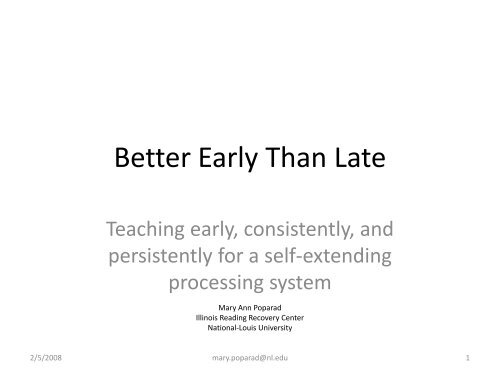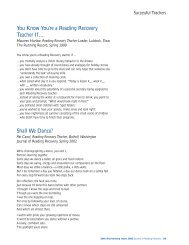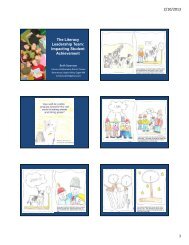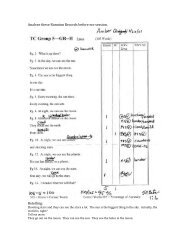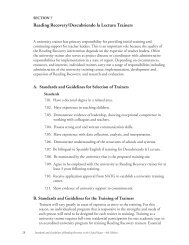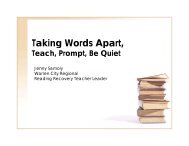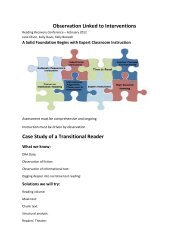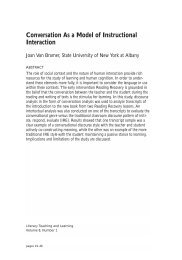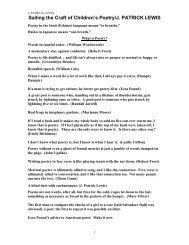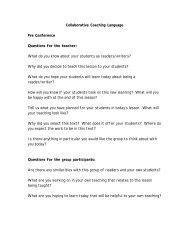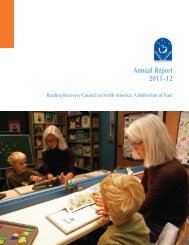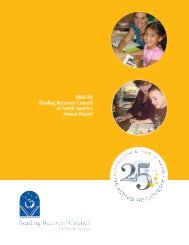Mary Ann Poparad - Better Early Than Late
Mary Ann Poparad - Better Early Than Late
Mary Ann Poparad - Better Early Than Late
- No tags were found...
You also want an ePaper? Increase the reach of your titles
YUMPU automatically turns print PDFs into web optimized ePapers that Google loves.
<strong>Better</strong> <strong>Early</strong> <strong>Than</strong> <strong>Late</strong>Teaching early, consistently, andpersistently for a self‐extendingprocessing system<strong>Mary</strong> <strong>Ann</strong> <strong>Poparad</strong>Illinois Reading Recovery CenterNational‐Louis University2/5/2008 mary.poparad@nl.edu 1
<strong>Better</strong> to be early than late!1. Explain a “processing system”2. Recognize an individual processing systemunder construction3. Create many chances for the child to searchfor and use multiple information sourcesfrom the very beginning and continuously2/5/2008 mary.poparad@nl.edu 2
Talk about the processing ! ?• Young constructive readers and writers work atsolving sentences and messages by– Choosing between alternatives– Changing responses rapidly at any point• Attending to different kinds of knowledge as theyare searching, selecting, rejecting, selfmonitoringand self‐correcting• LLP1, p. 32/5/2008 mary.poparad@nl.edu 3
“You relate what you hear or see to things you already understand.”“The moment of truth is the moment of input,how you attend,how much you care,how you encode,what you do with it,and how you organize it.”How do you become more savvy about the way you remember things?Have a good system. Notice your errors and try to fix them.LLP2 Inside cover & page 101
Processing? What is that?• Finding the information in print• Using the information found in print• Making decisions2/5/2008 mary.poparad@nl.edu 5
Working with several information sourcesinvolves….•Picking up informationAttending, noticing, being aware•Working with the informationDifferent kinds of information in a variety of contexts•Putting it all togetherMultiple sources converge2/5/2008 6
Processing system for reading….• Begins when the child is expected to composeand write a simple text• First working system– Expecting messages to exist in written form– Some information is visible in the print and layout– Some information is invisible– Change Over Time, p. 972/5/2008 mary.poparad@nl.edu 7
Learning to look at print• The child must learn…– To attend to some features of print– To follow rules about direction– To attend to words in sequence– To attend to letters in a word left to right insequence– Until the child attends to print in an organized waythe teacher’s moves or questions or commentswill confuse him. (LLP2 p3)2/5/2008 mary.poparad@nl.edu 8
An interactive theory• “I cannot assume that children will construct thesources of knowledge about the arbitrary writtencode entirely alone . . .• co‐construction occurs during interaction withknowledgeable adults.• The adult must enlist the child’s attention andeffort and provide helpful information inresponse to what the learner is able to do.”• Change Over Time p. 1022/5/2008 mary.poparad@nl.edu 9
Invisible Information• Listen to how the reading sounds; how thechild puts words together• The delivery (oral reading) reflects reader’sinterpretation of the meaning• Sammy at the farmSammy saw a horse butt / (but)The horse didn’t see Sammy.2/5/2008 mary.poparad@nl.edu 10
Recognizing a processing system underconstruction• Begins to seek more information– (re‐reads, tries again, asks for help)• Begins to detect errors because of what he is learning aboutthe visual forms of print and their relationship to the sounds of his spokenlanguage.• Clay, M. (1991), Becoming Literate: The construction of inner control, Hinemann, p. 1972/5/2008 mary.poparad@nl.edu 11
The system is developing….• The reader can draw from– current understanding,– oral language competencies,– visual information,– phonological information and– knowledge of printing conventions,• in ways which extend both the searchingand linking processes as well as the itemknowledge repertoires.M. Clay (2001) C.O.T. p. 2242/5/2008 12
How teachers contribute…• Taking advantage of learning opportunities– Interacting with partially correct responses• Prompting to influence improved choices• Altering the interaction depending on the difficulty ornewness of the task• Working along a sliding scale of least to most help• COT p. 982/5/2008 mary.poparad@nl.edu 13
Roaming around the known• Time to teach the brain…– to be aware of things stored; to call up usefulstrategic actions– to practice accessing and using that knowledge– to gear up to actively using his eyes, his ears, andhis thinking. (LLP1, p 33)2/5/2008 mary.poparad@nl.edu 14
Brain functions• “You relate what you hear or see to things youalready understand.” (LLP2, p.102)• Vision is not a one way street from the eyesto the brain. (p. 100)2/5/2008 mary.poparad@nl.edu 15
Saying and doingLooking and doing are intertwined.• Reading and writing demands that differentkinds of knowledge are pulled together.In the beginning this is a challenge.• An observant teacher knows how and when tohelp the child achieve the necessarycoordination.2/5/2008 mary.poparad@nl.edu 16
Some early connections…• Story with oral language– Invite, entice the child into a partial reconstructionor conversation around a carefully selected storyas lead into shared writing.• Link hearing with movement– LLP2 p.33 Example –Kevin– Clapping syllables heard– Using Elkonin boxes for sound analysis2/5/2008 mary.poparad@nl.edu 17
Assembling MessagesReading, Writing, Speaking• Attention is on assembling the message fromthe word level up (most of the time).• Focus is more on the assembling processesthan on the breaking down processes.2/5/2008 mary.poparad@nl.edu 18
Assembling MessagesGreat potentialLLDFI P Two p. 84• Seriously important outcomes can be expectedand observed…– Is the child monitoring ?– Is the child self‐correcting; checking even beforemanipulating some of the pieces?– Did the child change the level of her attention• Phrase• Word• Letter2/5/2008 mary.poparad@nl.edu 19
Assembling MessagesLLDFIP2 p. 84• In what parts did the child work with speed,fluency and accuracy?• When did she have to slow down?• What part of the processing needed extraattention?2/5/2008 mary.poparad@nl.edu 20
Assembling cut‐up stories: Reading, Writing,Speaking• Interrelationships of three language activitiesbecome obvious to children as they learnabout:– One‐to‐one correspondence (spoken & written words)– Direction– Checking– Monitoring– Self‐correcting– Breaking oral language into segments– LLP2 p. 821‐822/5/2008 mary.poparad@nl.edu 21
What do proficient readers do whilereading?– Build complex reading processes from thebeginning stages of learning to read– Take multiple routes to problem solving– Change direction when selected route fails– Maintain focus on meaning22
Processing Systemmay be under construction or already existChange Over Time, p. 123.Example A• Processing System UnderConstruction• Slow working, linking anddeciding• Attention given to:– Learning how to pick upinformation– Learning how to linkinformation– Learning how to checkinformationExample B• Processing System IsAvailable• Rapid processing• Attention given to:• Rapid parallel processing• If teachers want to see therapid recognition (B) theyhave to help the learner tobuild the working system(A).
Keep in mind….• Many different kinds of knowledge interact with each otherearly and begin to converge• As each new feature of the code is noticed the child isenabled to notice more of the code.– [Can you put a lollipop in your…. (that looks like that one)• It takes longer to assemble the first pieces of a puzzle; themore complete the puzzle, the quicker you can place the lastpieces. LLP2 342/5/2008 mary.poparad@nl.edu 24
Teacher’s Contribution to the child’sconstuction• Attend more to writing early LLP1 p 28• Clear up concept confusions early(letter/word/first/last)• Influence the choices made by constructivelearner– Improving the choices to become more efficient, morefocused, more rapid– Altering interaction (scale of help)– Change Over Time p.982/5/2008 mary.poparad@nl.edu 25
Do you have a bias?Highly successful teachers appeared to have a bias towardprompting for text‐level strategies; however, they did notneglect the use of visual information or attention to words.They help children analyze words using larger “chunks” ofinformation in addition to letter‐sound correspondence.Teachers with lower student outcomes tended to focusmore on letters and words and less on text‐levelstrategies. They attended to letter‐soundcorrespondence often; yet they did not appear to worktoward helping the child use word analysis “on the run”while reading continuous text.26
• When teacher is the authority, learning isblocked• Prompting at too low or too high a level willdraw child’s attention away from problem tobe solved• Goal: To facilitate the child’s system that iscurrently under construction…2/5/2008 mary.poparad@nl.edu 27
Teacher’s response• Focus on what action or non action will causelift in processing system• Observe and respond to the processing systemcurrently under construction– Partially correct– Where child is attending, trying, asking for help2/5/2008 mary.poparad@nl.edu 28
Ways of knowing change over time• Increased, slow, deliberate attention comes beforefluency & flexibility.• Consider the child’s current degree of control beforecalling for speeded responses2/5/2008 mary.poparad@nl.edu 29
Teacher Decision Making• When to teach– Where child seems to be trying, thinking, working• What to teach– Set goals; update predications of progress; recordwhat you did & child’s response• How to teach– Along a scale of help• Why to teach it2/5/2008 mary.poparad@nl.edu 31
Orientation“The more we give in the way of ‘gifts’ (likemeaning and structure during bookorientation), the more the child will giveus in the way of problem‐solving on therun, integrating all cueing sourceseffectively and efficiently”Keeping the Processing Easy at Higher Levels of Text Reading, P. Kelly and J. Neal
A great irony…• “At first, there is a discrepancy and aseparation between children’s reading andspelling. They often can not read some wordswhich they know how to spell and also fail tospell some words which they can read.”• ‐Goswami, U. and Bryant, P. (1990). Phonological skills and learning to read, Psychololgy Press, U.K.2/5/2008 mary.poparad@nl.edu 35
An explanation….• At first, the wholeness of the story text providesthe child with support. He begins by generating atext to fit the story, the illustrations and theteacher’s introduction but not without attentionto words.• At first he detects errors of meaning or sentencestructure by reference to his oral language systemand when they occur he is expected to try tosolve the problem by reading work.‐ p. 197 Clay, M. (1991),Becoming Literate: The construction of inner control, Hinemann.2/5/2008 mary.poparad@nl.edu 36
An internal processing system• The internal structure of mental activity(strategic actions) used in reading and writing• The process or act of coming to know throughawareness, perception, reasoning, intuition,judgment, deciding• Cognition is the larger mental activity thatuses sensory information that is perceived2/5/2008 mary.poparad@nl.edu 37
Finding and using information• Acts of perceiving, recognizing, interpretingsensory input from– Hearing– Feeling– Seeing– Touching– Tasting2/5/2008 mary.poparad@nl.edu 38
Part One, Page 63And in the endit is the individual adaptationmade by the expert teacherto that child’s idiosyncratic competenciesthat starts him/her on the upward climbto effective literacy performances.


